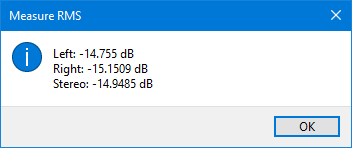Measure RMS
The primary purpose of this plug-in is to serve as an example for Nyquist Plug-in writers, of how translations may be added to plug-ins. All other plug-ins that are shipped with Audacity have translations compiled into the main application, but this is not practical for additional plug-ins that are not shipped with Audacity.
The translation mechanism available for "third party" plug-ins is limited to translating messages only, and not the GUI. This plug-in includes translations for 5 languages, though any number of languages may be added. Documentation for adding translations to Nyquist plug-ins can be found in the Audacity wiki.
- Accessed by:

This is a simple analyzer which measures the RMS level of the selected audio.
It is similar to , but without all the additional accessibility functionality.
The example above is the measurement of a typical stereo track where what is measured is:
- left channel
- right channel
- the stereo signal
If you use this analyzer on a mono track you will just get a single figure shown.